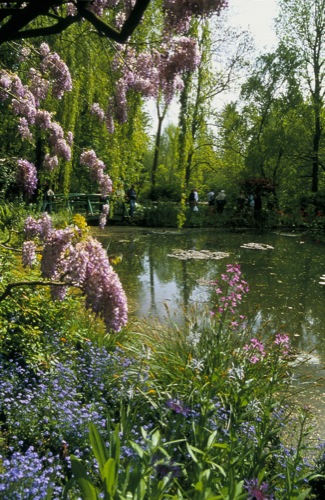
Claude Monet’s Garden, by Catherine Bibollet
A Tale of Two Countries
Few places have been as inextricably linked as Normandy and England, and the story of how that tie came to be can be seen in the famous tapestry in the Museum of Bayeux.
The tapestry, part of the UNESCO “Memory of the World” program, is a scroll of woven linen on which is embroidered the story of William, Duke of Normandy. Believing himself the rightful heir to the throne of England, he fought and defeated King Harold at the Battle of Hastings, going down in history as William the Conqueror.
Legends abound as to who commissioned the 11th-century tapestry, although contemporary scholars have settled on William’s half brother, Bishop Odo, who fought alongside him at Hastings. One of the tapestry’s more humorous panels shows Odo swinging his club, illustrating that as a religious man, he was forbidden to spill blood but was permitted to “knock a man senseless.”
The medieval town of Bayeux is itself well worth a visit, with its architecture of black-and-white half-timbered buildings. Even if you don’t stay at L’Hotel Lion d’Or — suitable for groups of up to 60 — stop in for a meal. The atmospheric inn is full of wonderful photographs of illustrious past guests, including general Dwight Eisenhower, general Omar Bradley and British field marshal Bernard Montgomery, who stayed there after the Allied invasion of Normandy.
Saints Michael and Joan
No trip to Normandy is complete without a visit to Mont-Saint-Michel, the 11th-century abbey built on a rocky outcrop in the English Channel. Dedicated to St. Michael the Archangel, who, according to legend, fought the devil in the guise of a dragon, the abbey became a place of sanctuary and pilgrimage while, at the same time, serving as a fortress against the ever-pesky English.
Anyone who has visited St. Michael’s Mount in Cornwall, on the English side of the Channel, will be surprised at the French version. While the English abbey is privately owned and stands alone atop its promontory, Mont-Saint-Michel is a small community, with hotels, shops and restaurants spread out below the abbey.
Be forewarned: The climb to the abbey — up steps cut into sheer rock — is an aerobic workout at best and can be treacherous after a rain. Don’t be deterred, though, as the chance to see the church, chapel, cloister and crypts makes the trek worth the effort.
Rouen is best known for its association with Joan of Arc. In 1430, at the height of France’s Hundred Years War with England, teenage peasant Joan followed the voices in her head, leading an army against the English and liberating the town of Orleans.
After failing to liberate Paris and betrayal by the powerful Duke of Burgundy, she was brought to Rouen for trial and, in 1431, at the age of 19, was burned at the stake. The modern church named in her honor in the Place du Vieux-Marche has a controversial exterior design said to represent her funeral pyre.
There’s nothing controversial about Rouen’s most famous church, Notre Dame Cathedral, which is the subject of a famous series of paintings by Claude Monet that now hang in the Musee d’Orsay in Paris.
The Restaurant La Couronne is another type of museum — a gastronomic one. It was there, in 1949, that Julia Child sat down for her first dinner in France: oysters on the half shell, sole meuniere and a dessert of fruit with creme fraiche, accompanied by a bottle of Pouilly-Fuisse. Should you wish to re-create that memorable dining experience, the staff, accustomed to the request, will happily oblige.










